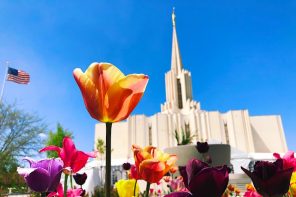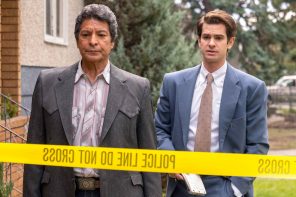On Thursday, I’ll be a guest on NPR’s Radio West with Mormon historian Claudia Bushman to discuss Mormon feminism.
Because, if you haven’t heard: Mormon feminism is back.
(And I can now feel my Mormon feminist elders poking me, reminding me that Mormon feminism never really went away. We were just resting.)
To prepare for the show, I’ve queried actual Mormon feminists as to what they’d like the world to know about us. And here it is:
Mormon feminism is not an oxymoron. Or an oxymormon, for that matter.
A Mormon feminist is a Mormon woman (or man) who believes that no human being should have lesser chances for a productive, healthy, fulfilling life because she happens to be born female.
Yes, oh, yes, we exist.
And we always have. There have been Mormon feminists since the earliest days of the LDS Church’s founding in the 1830s. Take, for example, Emma Smith, wife of Church founder Joseph Smith, a woman of incredible strength and independence, a woman who organized and led other women in the Church’s then-independent Relief Society, and who seriously challenged if not openly rejected the innovation of the doctrine of polygamy.
Mormon feminists also look to our pioneer foremothers, many of whom demonstrated exceptional courage and physical fortitude as they were driven from their homes in the Midwest and crossed the plains to Utah. Women in Utah first won the right to vote in 1870. And Mormon women in the late nineteenth century were sent back east to train as medical doctors, encouraged by Brigham Young himself, who said in 1869:
We believe that women are useful, not only to sweep houses, wash dishes, make beds and raise babies, but they should stand behind the counter, study law or physic, or become good bookkeepers and be able to do the business in any counting house, and all this to enlarge their sphere of usefulness for the benefit of society at large. In following these things they but answer the design of their creation.
Like every world religion, Mormonism has a mixed record on gender. Over the years, we’ve lived through periods of expansiveness and retrenchment, including in the 1990s the excommunication of feminists and a renewed if not innovated emphasis on essentialist gender roles. But our theology has some startlingly pro-feminist aspects. For example, Mormon theology holds that just as we have a Father in Heaven, we also have a Mother in Heaven, and that godhood belongs jointly to our Heavenly Parents. In the late 20th century, it became taboo to talk about Heavenly Mother within orthodox Mormonism. Mormon feminists restore her name to our speech, our thoughts, and the version of Mormon theology we are teaching our children.
That’s right: in Mormonism, God is a man and a woman.
There is no consensus among Mormon feminists on the issue of women and priesthood. Some Mormon feminists believe that women should be ordained to the tradition’s lay priesthood. Some believe that Mormon women already enjoy a form of priesthood conveyed during LDS temple ceremonies. Some believe that the issue of women and priesthood ordination often distracts from other pressing questions of equality in the institutional church. They ask, why is the operational chain of command all male? What if women were systematically included in shaping Church operations like curriculum development, finances, even the keeping of membership records? What if our Church worked more like our actual Mormon homes and families do—where there is partnership and responsibility-sharing?
Like all social movements, Mormon feminism has experienced cycles of growth and retrenchment. We’ve see many Mormon feminists and feminist-identified men discontinue activity in the institutional LDS Church after difficult historical episodes like the ERA in the 1970s and 1980s, the purge of feminists and intellectuals in the 1990s, and Proposition 8 in 2008. But with every generation, new Mormon feminists are born: women who grow up drawing strength from a Mormon theology that gives them an image of their own divinity and that teaches them they are entitled to pray and receive their own answers, as well as from the examples of our pioneer foremothers. Mormon feminists—like all people of faith—may have different relationships to the institutional Church over the course of a lifetime. But Mormon feminism isn’t going anywhere.
The internet has been a major game changer for Mormon feminists. In past decades, “out” Mormon feminists were concentrated in geographical pockets in Boston, or Utah, or California, and those who became visible through their activism or writing became the targets of repression or excommunication. That really changed with the advent of sites like feministmormonhousewives.org, which was launched in 2004. In the blogosphere—we Mormons call it the “bloggernacle,” kind of like “tabernacle”—women who may have once felt isolated in their congregations have found a safe space to communicate and collaborate. The internet has diversified Mormon feminism and dramatically increased its accessibility.
Our issues as Mormon feminists are expansive. Mormon feminists led the faithful opposition to Proposition 8. We believe in dignity and equality for LGBT people, including our parents, brothers and sisters, and children who are LGBT Mormons. We are also concerned about the immigration debate. We know that our Latino brothers and sisters—including many Latino Mormons—are having their family lives disrupted by anti-immigrant legislation. Some are living in fear of deportation. This is a Mormon feminist issue.
Mormon feminists are also concerned about the rising generation of Mormon women. There’s a statistic circulating on the Mormon grapevine that the LDS Church is losing a very significant percentage of young women members. We know that Mormonism is a tradition that can convey a great deal of strength, and we want our young women to draw strength from our tradition. One terrific example of this outreach is the new Mormon feminist organization LDS WAVE (Women Advocating Voice and Equality), which has just launched its new website.
It’s a good time to be a Mormon feminist.




